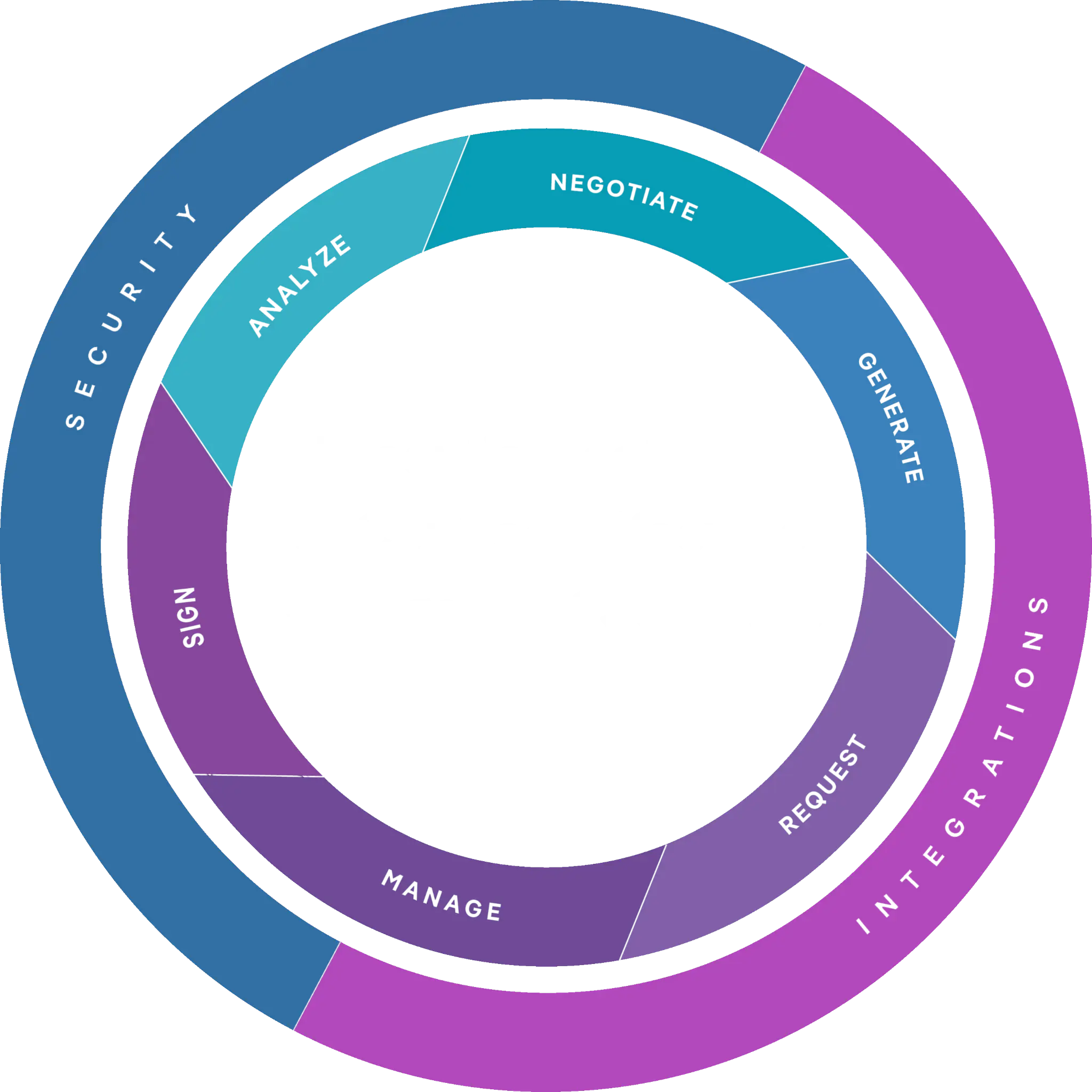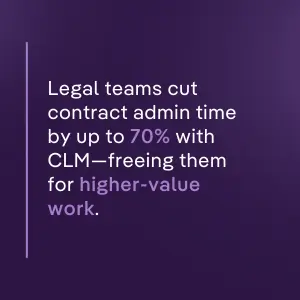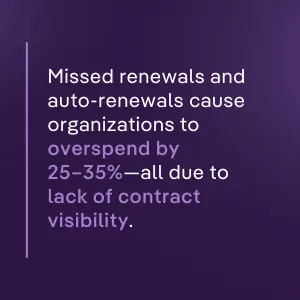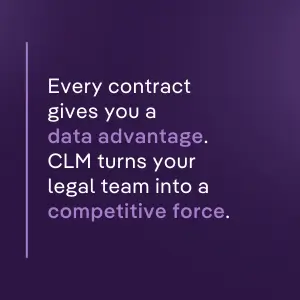Published: June 6, 2023
Updated: July 16, 2025

Let me paint you a picture that’s probably all too familiar: It’s 4:30 PM on a Friday, and your CEO walks into your office asking about the termination clause in that vendor agreement from 2019. You know—the one buried somewhere in your shared drive, probably in a folder called “Contracts – Misc” or maybe “Legal Stuff 2019 – Final Version.”
Sounds about right?
If you’re nodding along, you’re definitely not alone. Most legal teams are drowning in contract chaos, and honestly, it’s not your fault. The traditional approach to contract management—think spreadsheets, email chains, and the occasional panic attack when renewal deadlines sneak up—just wasn’t built for today’s business reality.
Here’s what we’re dealing with: The average Fortune 1000 company juggles somewhere between 20,000 to 40,000 active contracts at any given moment. That’s not a typo. Twenty thousand. And if you’re managing even a fraction of that number manually, well, my hat’s off to you because that’s basically impossible.
This is where Contract Lifecycle Management (CLM) comes in. But before you roll your eyes and think “great, another tech solution promising to solve all my problems,” hear me out. CLM isn’t just about digitizing your contracts—though that’s certainly part of it. It’s about fundamentally changing how your legal team operates, from reactive firefighters to strategic business partners.
Here are the ten ways CLM can transform your legal operations (and maybe save your sanity in the process).
1. You’ll Actually Have Time to Practice Law Again

Remember why you went to law school? It probably wasn’t to spend your afternoons playing detective, hunting down contract versions, or chasing approvals through email chains that somehow involve seventeen people (plus a couple of folks that may not even work here anymore).
With CLM, contract creation becomes almost embarrassingly simple. Pre-approved templates mean you’re not starting from scratch every time. Automated workflows route documents to the right people without you having to remember who needs to sign off on what. And that approval process that used to take three weeks? Try three days.
I’ve seen legal teams cut their administrative time by 60-70% after implementing CLM. Suddenly, you’re not the person who tracks down signatures—you’re the strategic advisor helping the business make smarter deals. That’s the kind of transformation that makes Monday mornings feel different (and let you head out early on a Friday afternoon).
2. Compliance Becomes Your Friend, Not Your Enemy
Let’s be honest—compliance anxiety is real. That nagging worry that you’ve missed something, that a regulatory change slipped by, or that someone in procurement approved terms that make your stomach turn. CLM eliminates most of that worry.
Every contract follows the same review process. No exceptions, no shortcuts, no “just this once” scenarios. When regulations change, your templates update automatically across the board. Unusual terms get flagged before they become problems, not after they’ve already caused damage.
The best part? Your team stops being the “department of no” and starts being the group that helps the business move fast while staying safe. That’s a much better place to be.

3. You’ll Know What You Don’t Know (And Fix It)
Quick question: How many contracts expire in the next 90 days? Which ones auto-renew? What’s your total contractual liability across all vendor agreements?
If you can’t answer these questions in about thirty seconds, you need CLM. A centralized repository turns your contract portfolio from a mystery novel into an open book.
Real-time dashboards show you exactly where everything stands. You’ll spot bottlenecks before they become crises. You’ll catch renewal opportunities before they become expensive auto-renewals. Most importantly, you’ll make decisions based on actual data instead of educated guesses.
4. Your Contracts Will Start Talking to You
Here’s something that might surprise you: Your contracts are full of business intelligence. You just can’t access it when everything’s scattered across different systems and file formats.
CLM platforms turn your contracts into a goldmine of insights. Which vendors consistently push back on your standard terms? Where do negotiations typically get stuck? What contract types take the longest to close? These patterns help you negotiate better, plan better, and advise the business better.
I’ve seen legal teams use contract data to predict which deals are likely to face delays, which vendors might need contract modifications, and even which business units need additional contract training. That’s the kind of strategic value that means you get to choose the restaurant when the deal closes, instead of David from Sales (seriously, can we get sushi instead of steak just once?)…
5. The Silos Finally Come Down
Contracts touch everyone—legal, procurement, sales, operations, finance. Yet somehow, these teams often feel like they’re working in parallel universes. CLM bridges these gaps through shared workspaces and transparent processes.
Suddenly, procurement can see exactly where legal reviews stand. Sales knows precisely what’s holding up their deals. Operations understands their upcoming obligations. This transparency doesn’t just speed things up—it reduces the friction that drives everyone crazy.
The result is faster deal cycles, better internal relationships, and contracts that actually reflect what the business needs instead of what legal thinks the business might need.
6. AI Becomes Your Research Assistant
Let’s talk about artificial intelligence for a minute. In 2025, AI-powered contract analysis isn’t science fiction—it’s Tuesday afternoon. These systems review contracts in seconds, catching risks and opportunities that even experienced attorneys might miss on a busy day.
But here’s what’s really exciting: AI democratizes contract intelligence. Information that used to require years of legal experience becomes accessible to business users through intuitive dashboards and plain-language summaries. Your procurement team can understand contract risks without calling you for every vendor agreement.

Predictive analytics take this even further. The system learns from your contract history and starts forecasting potential issues. You’ll know which contracts are likely to face disputes, which vendors typically request extensions, and where to focus your attention for maximum impact.
7. The ROI Is Actually Measurable
CLM isn’t just about making your life easier—though it certainly does that. The financial benefits are substantial and measurable.
By eliminating manual processes, you reduce the human hours required for contract management. Your team focuses on high-value legal work instead of administrative tasks. Automated alerts ensure you never miss renewal deadlines or compliance requirements.
One avoided penalty or one caught renewal opportunity often pays for the entire CLM investment. I’ve seen organizations save hundreds of thousands of dollars in their first year just by catching favorable renewal terms they would have otherwise missed.
Consider the hidden costs that CLM eliminates: missed obligations, unfavorable auto-renewals, expensive contract disputes, and the opportunity cost of slow deal cycles. These savings add up quickly.
See how ContractPodAi’s AI-powered CLM solution delivers real cost savings and ROI in this video:
8. Your Relationships Actually Improve
Clear communication builds trust. When everyone understands their contractual obligations and can easily access contract terms, relationships improve dramatically.
CLM systems ensure consistent contract performance through automated reminders and obligation tracking. Vendors appreciate working with organizations that are professional and prepared. Internal clients value legal teams that make doing business easier, not harder.
This reputation for contractual excellence becomes a competitive advantage. Better partners want to work with you. You get more favorable terms because you’re seen as a reliable counterparty. Your organization becomes known for honoring commitments and making contracting straightforward.
9. Growth Doesn’t Have to Hurt
Your contract volume will grow (and it should, in a growing and expanding company!). The only question is whether your processes can keep pace. CLM platforms scale from hundreds to hundreds of thousands of contracts without proportional increases in staff or complexity.
Customizable workflows adapt to your organization’s unique needs. Technology contracts require different processes than real estate agreements, and CLM platforms accommodate these differences seamlessly. As your business evolves, your contract management evolves with it.
This flexibility extends to global operations. Multi-language support, regional compliance tracking, and local workflow variations all configure within the same platform. International expansion doesn’t mean starting over with contract management.

10. You’ll Actually Get Ahead of the Competition
Organizations using CLM close deals faster, manage risk better, and operate more efficiently than their competitors. This isn’t about keeping up—it’s about pulling ahead.
While your competitors struggle with manual processes, you’re leveraging AI-powered insights. While they react to contract problems, you’re preventing them. While they guess at their contractual position, you know exactly where you stand.
This advantage compounds over time. Every contract adds to your data advantage. Every process improvement widens the gap. Every efficiency gain strengthens your competitive position. Often, this means that you and your legal team, regardless of size, begins to be seen as a benefit, a sales-driver, and a team of superheroes—your very own “Justice League” (at least for contracts, I suppose).
The Bottom Line
Contract Lifecycle Management delivers measurable benefits across every aspect of legal operations: operational efficiency through automation, risk mitigation via standardized processes, strategic insights from contract data, cost reduction by eliminating manual work, and competitive advantage through faster, smarter contract management.
The question isn’t whether to implement CLM—it’s how quickly you can start capturing these benefits. Organizations that delay fall further behind as competitors accelerate with intelligent contract management.
Your contracts represent relationships, obligations, and opportunities. They deserve better than spreadsheets and shared drives. They deserve a system that transforms them from administrative burdens into strategic business assets.
Ready to see what CLM can do for your legal team? ContractPodAi’s AI-powered platform helps legal teams transform their contract operations. Schedule a demo and discover why leading organizations trust ContractPodAi to manage their most important business relationships.


